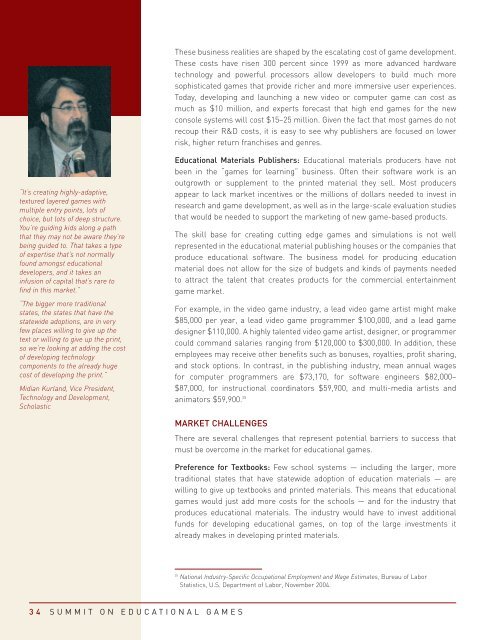Summit on Educational Games - Federation of American Scientists
Summit on Educational Games - Federation of American Scientists
Summit on Educational Games - Federation of American Scientists
You also want an ePaper? Increase the reach of your titles
YUMPU automatically turns print PDFs into web optimized ePapers that Google loves.
“It’s creating highly-adaptive,<br />
textured layered games with<br />
multiple entry points, lots <strong>of</strong><br />
choice, but lots <strong>of</strong> deep structure.<br />
You’re guiding kids al<strong>on</strong>g a path<br />
that they may not be aware they’re<br />
being guided to. That takes a type<br />
<strong>of</strong> expertise that’s not normally<br />
found am<strong>on</strong>gst educati<strong>on</strong>al<br />
developers, and it takes an<br />
infusi<strong>on</strong> <strong>of</strong> capital that’s rare to<br />
find in this market.”<br />
“The bigger more traditi<strong>on</strong>al<br />
states, the states that have the<br />
statewide adopti<strong>on</strong>s, are in very<br />
few places willing to give up the<br />
text or willing to give up the print,<br />
so we’re looking at adding the cost<br />
<strong>of</strong> developing technology<br />
comp<strong>on</strong>ents to the already huge<br />
cost <strong>of</strong> developing the print.”<br />
Midian Kurland, Vice President,<br />
Technology and Development,<br />
Scholastic<br />
These business realities are shaped by the escalating cost <strong>of</strong> game development.<br />
These costs have risen 300 percent since 1999 as more advanced hardware<br />
technology and powerful processors allow developers to build much more<br />
sophisticated games that provide richer and more immersive user experiences.<br />
Today, developing and launching a new video or computer game can cost as<br />
much as $10 milli<strong>on</strong>, and experts forecast that high end games for the new<br />
c<strong>on</strong>sole systems will cost $15–25 milli<strong>on</strong>. Given the fact that most games do not<br />
recoup their R&D costs, it is easy to see why publishers are focused <strong>on</strong> lower<br />
risk, higher return franchises and genres.<br />
Educati<strong>on</strong>al Materials Publishers: Educati<strong>on</strong>al materials producers have not<br />
been in the “games for learning” business. Often their s<strong>of</strong>tware work is an<br />
outgrowth or supplement to the printed material they sell. Most producers<br />
appear to lack market incentives or the milli<strong>on</strong>s <strong>of</strong> dollars needed to invest in<br />
research and game development, as well as in the large-scale evaluati<strong>on</strong> studies<br />
that would be needed to support the marketing <strong>of</strong> new game-based products.<br />
The skill base for creating cutting edge games and simulati<strong>on</strong>s is not well<br />
represented in the educati<strong>on</strong>al material publishing houses or the companies that<br />
produce educati<strong>on</strong>al s<strong>of</strong>tware. The business model for producing educati<strong>on</strong><br />
material does not allow for the size <strong>of</strong> budgets and kinds <strong>of</strong> payments needed<br />
to attract the talent that creates products for the commercial entertainment<br />
game market.<br />
For example, in the video game industry, a lead video game artist might make<br />
$85,000 per year, a lead video game programmer $100,000, and a lead game<br />
designer $110,000. A highly talented video game artist, designer, or programmer<br />
could command salaries ranging from $120,000 to $300,000. In additi<strong>on</strong>, these<br />
employees may receive other benefits such as b<strong>on</strong>uses, royalties, pr<strong>of</strong>it sharing,<br />
and stock opti<strong>on</strong>s. In c<strong>on</strong>trast, in the publishing industry, mean annual wages<br />
for computer programmers are $73,170, for s<strong>of</strong>tware engineers $82,000–<br />
$87,000, for instructi<strong>on</strong>al coordinators $59,900, and multi-media artists and<br />
animators $59,900. 25<br />
MARKET CHALLENGES<br />
34 SUMMIT ON EDUCATIONAL GAMES<br />
There are several challenges that represent potential barriers to success that<br />
must be overcome in the market for educati<strong>on</strong>al games.<br />
Preference for Textbooks: Few school systems — including the larger, more<br />
traditi<strong>on</strong>al states that have statewide adopti<strong>on</strong> <strong>of</strong> educati<strong>on</strong> materials — are<br />
willing to give up textbooks and printed materials. This means that educati<strong>on</strong>al<br />
games would just add more costs for the schools — and for the industry that<br />
produces educati<strong>on</strong>al materials. The industry would have to invest additi<strong>on</strong>al<br />
funds for developing educati<strong>on</strong>al games, <strong>on</strong> top <strong>of</strong> the large investments it<br />
already makes in developing printed materials.<br />
25 Nati<strong>on</strong>al Industry-Specific Occupati<strong>on</strong>al Employment and Wage Estimates, Bureau <strong>of</strong> Labor<br />
Statistics, U.S. Department <strong>of</strong> Labor, November 2004.
















